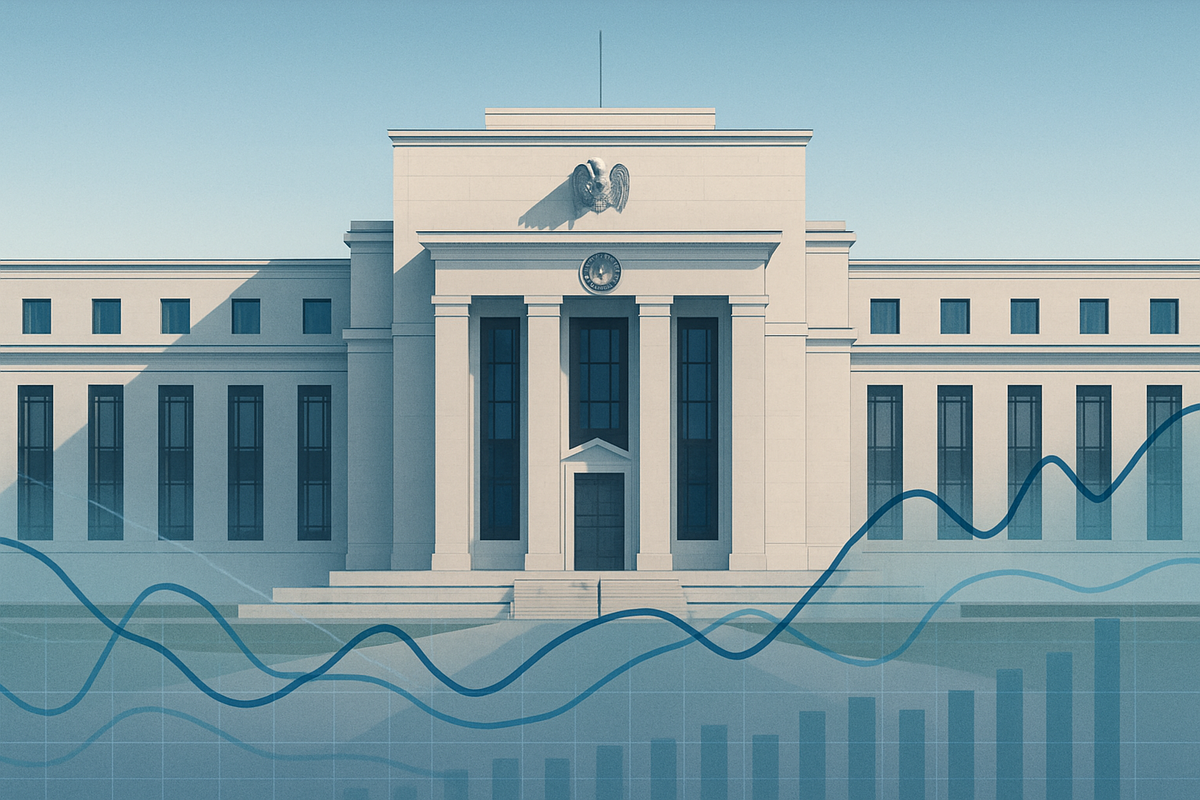
As the financial markets navigate a complex landscape of persistent economic indicators and evolving global dynamics, the assertion from Philadelphia Federal Reserve President Anna Paulson that the Federal Reserve would "react to a burst of inflation" serves as a potent reminder of the central bank's unwavering commitment to price stability. Assuming her role as President and CEO of the Federal Reserve Bank of Philadelphia on July 1, 2025, Paulson's hypothetical or anticipated stance underscores a continuation of the hawkish vigilance that has characterized the Fed's policy in recent years. This statement, whether explicitly made or implicitly understood through the Fed's recent history, signals that any resurgence in inflationary pressures would be met with decisive policy responses, potentially impacting everything from borrowing costs to corporate earnings.
The implications of such a strong declaration are significant. It suggests that the Fed, under its current leadership, remains acutely sensitive to inflation risks and is prepared to deploy its monetary policy tools to prevent a repeat of the widespread price increases experienced from 2021 to 2023. For investors, businesses, and consumers alike, this translates into an environment where interest rate policy is firmly tied to inflation data, and the prospect of higher-for-longer rates looms large should inflation deviate from the Fed's 2% target.
The Fed's Stance: A Historical Echo and Future Commitment
The context for Philadelphia Fed President Anna Paulson's (anticipated) assertion is deeply rooted in the recent history of the Federal Reserve's battle against inflation. From 2021 to mid-2022, the U.S. experienced a "burst of inflation" unseen in decades, with the Consumer Price Index (CPI) peaking at a staggering 9.1% in June 2022. This period was characterized by global supply chain disruptions, robust consumer demand fueled by fiscal and monetary stimulus, and exacerbated by geopolitical events such as the Russian invasion of Ukraine, which drove up energy and food costs.
During this tumultuous time, Paulson's predecessor, Patrick Harker, then-Philadelphia Fed President, notably described soaring inflation as "the 10% elephant in the room" in April 2022. He pledged strong action, forecasting "a series of deliberate, methodical [rate] hikes" to curb inflation. This commitment was echoed across the Federal Open Market Committee (FOMC), leading to an aggressive tightening cycle. The Fed initiated interest rate hikes in March 2022, moving the federal funds rate from near zero to a range of 5.25% to 5.5% by mid-2023, including multiple 75-basis-point increases. Concurrently, the Fed began reducing its balance sheet through quantitative tightening in June 2022. These actions, while initially met with skepticism by some who believed inflation to be "transitory," ultimately demonstrated the Fed's resolve to restore price stability, even at the risk of slowing economic growth.
Paulson's hypothetical statement, therefore, acts as a reaffirmation of this precedent. It signals that the current Fed, informed by past challenges, views its price stability mandate with utmost seriousness. The key players involved in this ongoing saga include the FOMC members, who collectively decide on monetary policy; financial markets, which react swiftly to any hint of policy shifts; and ultimately, American consumers and businesses, who bear the direct impact of inflation and interest rate changes. Any indication of renewed inflationary pressures would likely trigger a strong market reaction, with bond yields potentially rising and equity markets facing volatility as investors price in the possibility of further monetary tightening.
Market Winners and Losers in a Vigilant Environment
A Federal Reserve committed to reacting decisively to inflation creates a distinct landscape of potential winners and losers across various sectors of the economy. Companies that thrive in an environment of rising interest rates or demonstrate resilience against inflationary pressures are likely to benefit.
Potential Winners:
- Financial Institutions: Banks such as JPMorgan Chase (NYSE: JPM) and Bank of America (NYSE: BAC) typically see their net interest margins expand as interest rates rise, allowing them to earn more on loans.
- Companies with Pricing Power: Businesses that can pass increased costs onto consumers without significantly impacting demand tend to perform well. This often includes established consumer staples companies like Procter & Gamble (NYSE: PG) or utilities with regulated pricing.
- Energy and Commodity Producers: Should inflation be driven by commodity price increases, companies in the energy sector like ExxonMobil (NYSE: XOM) or mining companies could see increased revenues and profits.
Potential Losers:
- Growth Stocks and Technology Companies: High-growth technology firms, often valued on future earnings, can be particularly sensitive to rising interest rates, which increase the discount rate applied to those future cash flows. Companies like Tesla (NASDAQ: TSLA) or NVIDIA (NASDAQ: NVDA), despite strong fundamentals, could face valuation headwinds.
- Highly Leveraged Companies: Businesses with substantial debt burdens will face higher borrowing costs, potentially squeezing profit margins and limiting investment.
- Interest-Rate Sensitive Sectors: Real estate investment trusts (REITs) and construction companies can suffer as mortgage rates and development financing costs increase, dampening demand.
- Discretionary Consumer Goods: If inflation erodes purchasing power and higher rates increase household expenses, consumers may cut back on non-essential spending, impacting companies in sectors like apparel or leisure.
The Fed's vigilance thus forces companies to adapt, emphasizing robust balance sheets, efficient operations, and a clear strategy for navigating potentially higher capital costs and fluctuating consumer demand.
Broader Significance and Historical Precedents
Philadelphia Fed President Paulson's (anticipated) assertion fits squarely into a broader global trend of central banks prioritizing inflation control after the lessons learned from the post-pandemic surge. The event highlights several wider significances for the financial world and beyond. Firstly, it underscores the ongoing battle against persistent inflationary pressures that may arise from various factors, including evolving global supply chains, geopolitical tensions, and shifts in labor markets. The commitment to "react" implies that the Fed will not hesitate to use its tools, potentially influencing global capital flows and the strength of the U.S. dollar.
Secondly, the regulatory and policy implications are clear: the focus on price stability remains paramount. This could mean a continuation of a "higher for longer" interest rate environment if inflation proves sticky, or swift rate adjustments if new inflationary shocks emerge. Such a policy stance impacts government borrowing costs, corporate investment decisions, and household budgets. Historically, the Federal Reserve has demonstrated its capacity for aggressive action when faced with runaway inflation, most famously under Chairman Paul Volcker in the early 1980s, who engineered a sharp rise in interest rates to break the back of entrenched inflation. The 2022-2023 tightening cycle serves as a more recent precedent, demonstrating the Fed's willingness to act decisively, even if it entails some economic pain. The Fed's current approach seems to draw heavily from these historical lessons, aiming to prevent inflation from becoming embedded in economic expectations. Potential ripple effects include increased scrutiny on fiscal policy, as excessive government spending could fuel inflation and complicate the Fed's efforts. Competitors and partners of U.S. companies may also face similar pressures from their own central banks, leading to synchronized global monetary policy tightening.
What Comes Next: Navigating the Future Landscape
Looking ahead, Philadelphia Fed President Anna Paulson's (anticipated) stance on inflation outlines a clear path for what comes next in the financial markets. In the short term, investors will be closely watching economic data—particularly the Consumer Price Index (CPI), Personal Consumption Expenditures (PCE) price index, and wage growth figures—for any signs of a renewed "burst of inflation." Any uptick could trigger immediate market volatility, with bond yields rising and equity markets experiencing downward pressure as the probability of further Fed tightening increases. Companies will need to be agile, adapting to potentially higher borrowing costs and a more cautious consumer environment.
In the long term, this vigilance suggests a potential "higher for longer" interest rate environment, where the cost of capital remains elevated compared to the pre-2022 era. This could lead to strategic pivots for businesses, emphasizing efficiency, strong balance sheets, and organic growth over debt-fueled expansion. Market opportunities may emerge in sectors that are less sensitive to interest rates or those that benefit from a strong dollar, while challenges will persist for highly leveraged companies and growth stocks reliant on cheap capital. Potential scenarios range from a "soft landing," where inflation is controlled without triggering a severe recession, to a more challenging outcome if aggressive tightening leads to a significant economic downturn. Investors should also consider the possibility of "stagflation," where inflation persists alongside stagnant economic growth, a scenario the Fed is keen to avoid.
Comprehensive Wrap-up: A New Era of Vigilance
Philadelphia Fed President Anna Paulson's (anticipated) assertion that the Federal Reserve would "react to a burst of inflation" encapsulates the central bank's enduring commitment to its price stability mandate in a post-pandemic world. The key takeaway is clear: the Fed has learned from the inflationary surge of 2021-2023 and is prepared to act decisively to prevent a recurrence. This vigilance implies a monetary policy framework that is highly data-dependent and responsive, prioritizing the containment of inflation above all else.
Moving forward, the market will operate under the shadow of potential monetary tightening, meaning a potentially "higher for longer" interest rate regime. This environment necessitates a strategic shift for investors and businesses alike, focusing on resilience, prudent financial management, and a keen eye on macroeconomic indicators. The lasting impact of this stance is a reinforced understanding that the Fed will not tolerate sustained high inflation, even if it means tempering economic growth. Investors should closely monitor inflation reports, Fed communications, and global economic developments in the coming months, as these will provide critical clues about the trajectory of monetary policy and its ripple effects across the financial landscape.
This content is intended for informational purposes only and is not financial advice





